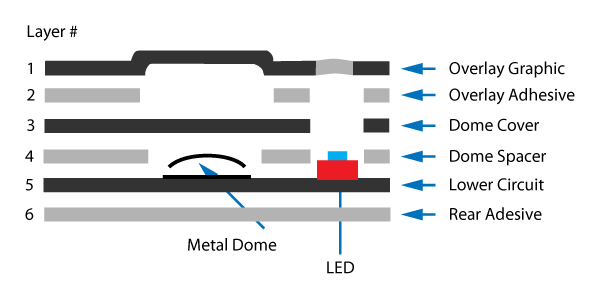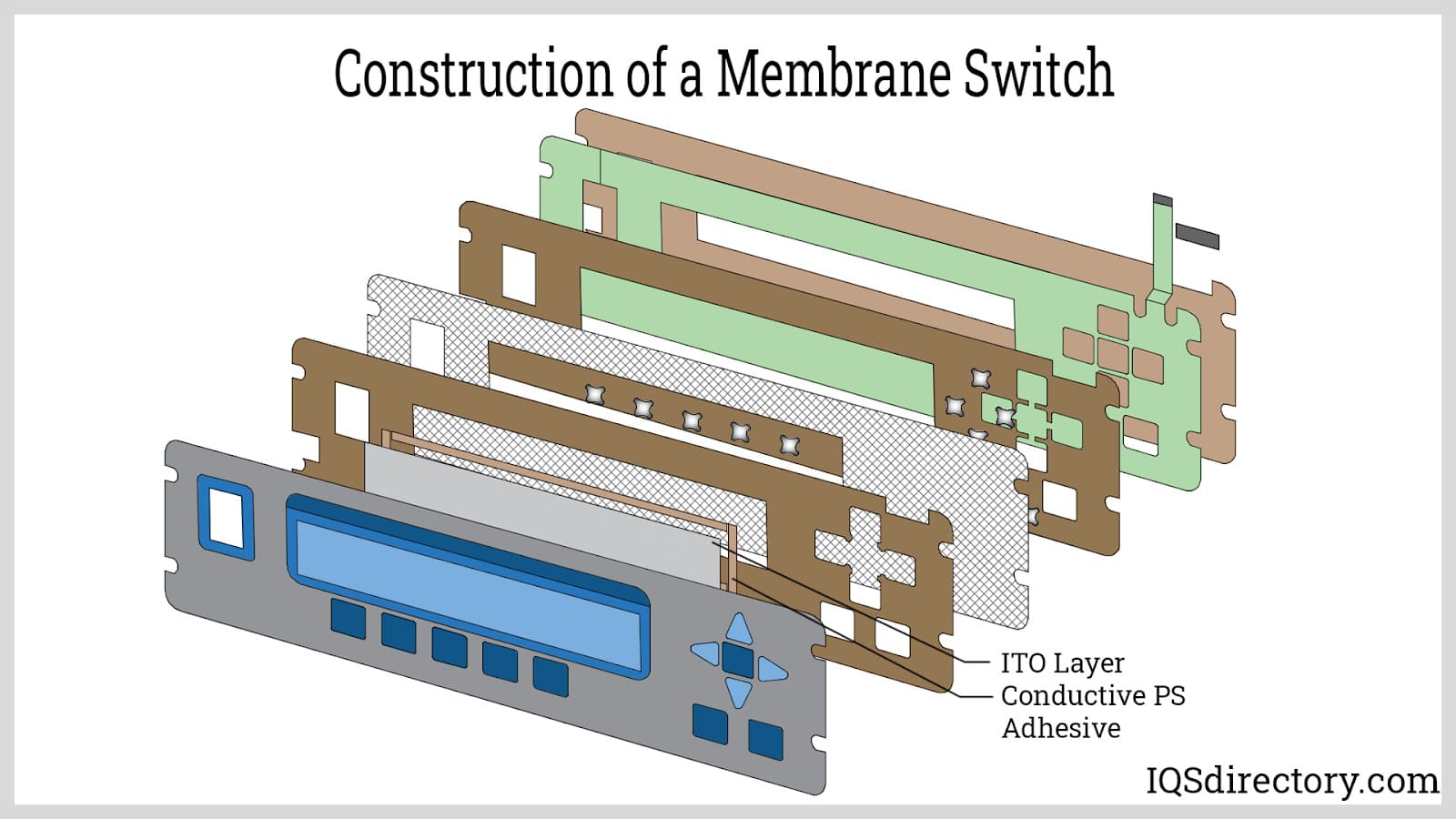Everything About Membrane Switch Over: A Comprehensive Guide for Beginners
Membrane layer switches are essential parts in modern electronic devices, providing a distinct user interface for individual communication - membrane switch. Their layered construction, including overlays and conductive traces, gives functionality and durability. Unlike standard mechanical switches, membrane buttons offer a smooth design and customizable choices. Recognizing their key attributes and advantages can change item style. The intricacies of their application and style considerations call for further exploration.
What Is a Membrane layer Switch?
A membrane button is a sort of electric switch that contains a versatile membrane layer layered over a published circuit card. This layout allows for a portable and smooth interface, typically used in various electronic gadgets. Membrane layer buttons are typically located in customer appliances, medical devices, and commercial equipment as a result of their toughness and resistance to ecological factors.The building usually consists of several layers, such as graphic overlays and adhesive support, which give tactile feedback and shield the circuitry underneath. The procedure of a membrane layer switch is started when pressure is related to the surface, completing an electric circuit.These switches are valued for their convenience, allowing custom-made designs and published graphics that satisfy certain interface. Their inconspicuous nature decreases area needs, making them ideal for applications where standard buttons may not fit. In general, membrane buttons use a practical and aesthetic remedy for contemporary electronic devices.
Trick Parts of Membrane Switches
Membrane layer changes make up a number of essential elements that add to their performance and performance. The top layer, recognized as the overlay, supplies the individual interface and is typically published with icons or graphics. Underneath the overlay lies a spacer layer, which divides the conductive aspects and prevents unintentional activation. The next vital element is the graphic layer, which boosts appearances and ensures the toughness of the design.Conductive traces, usually made from materials like silver or carbon, are published on the circuit layer. When pressure is used to the overlay, these traces enter into call, completing the circuit. In addition, a backing layer offers architectural support and can be made from products such as polyester or polycarbonate. Together, these components create a reputable, easy to use interface ideal for different applications, from household devices to industrial equipment. Comprehending these elements is crucial for any person thinking about membrane button modern technology.
Just How Membrane Switches Job
Recognizing how membrane switches over feature is vital for valuing their widespread use in different tools. A membrane switch operates with a collection of layers, consisting of a visuals overlay, spacer, and a circuit layer. When pressure is related to the overlay, it compresses the spacer layer, allowing the circuit layer to make contact and finish an electric circuit. This action sends out a signal to the tool, prompting a response, such as activating a light or turning on a function.Membrane switches can be designed with various functions, consisting of responsive comments, backlighting, and personalized graphics, boosting customer communication. Their building and construction permits a sealed design, safeguarding the interior elements from dust, moisture, and contaminants. This durability makes them suitable for diverse applications, from customer electronic devices to commercial devices. Generally, the simpleness and efficiency of membrane switches add to their appeal in modern technology.
Advantages of Membrane Switches Mechanical Switches
While mechanical switches have long been a staple in many gadgets, membrane changes deal distinctive benefits that make them increasingly appealing. One substantial advantage is their slim profile, allowing for even more compact designs and higher flexibility in item development. Furthermore, membrane layer switches function a consistent surface, which enhances aesthetic appeal and simplifies cleaning, making them ideal for atmospheres where health is critical.Another advantage is their resistance to dust and wetness. Unlike mechanical buttons, which can be jeopardized by environmental factors, membrane layer switches provide a closed interface that safeguards against impurities - membrane switch. Furthermore, membrane buttons commonly have a longer life expectancy due to less moving components, leading to boosted longevity and reliability.Cost-effectiveness is likewise a significant benefit, as membrane layer buttons can be created wholesale with lower production expenses. These elements incorporate to position membrane buttons as a practical option to traditional mechanical choices in numerous applications
Common Applications of Membrane Switches Over
Membrane buttons are widely used in different fields, particularly in customer electronics and industrial control panels. In customer gadgets, they provide a smooth, user-friendly user interface, while in industrial settings, they boost resilience and functionality. Understanding these applications highlights the adaptability and functionality of membrane layer switches in modern-day technology.
Consumer Electronics Tools
As customer electronic devices remain to advance, membrane layer buttons have actually come to be a preferred selection for a selection of tools as a result of their versatility and sleek design. These switches are commonly found in smartphones, tablet computers, and remote controls, where space is limited and looks issue. Their low profile and customizable designs permit suppliers to develop straightforward user interfaces that improve the general individual experience. Additionally, membrane buttons are usually made use of in devices such as microwaves and coffee machine, supplying instinctive control choices while withstanding wetness and dirt. The resilience and reliability of membrane layer switches over make them appropriate for daily consumer items, making sure durability and constant efficiency. Generally, their assimilation in customer electronic devices mirrors a mix of functionality and modern-day style.
Industrial Control Panels
The applications of membrane layer changes expand beyond customer electronics, finding substantial use in commercial control panels. These buttons are favored for their resilience and resistance to harsh atmospheres, making them perfect for making and procedure control settings. They supply a trustworthy interface for drivers to manage equipment, display processes, and readjust settings. Membrane layer switches can be customized to suit certain functional needs, integrating attributes like backlighting and tactile comments, improving customer experience. Their low-profile design enables for assimilation into different devices, while their ability to withstand spills, dirt, and severe temperatures warranties durability. Overall, membrane layer switches add to efficient and safe operation in industrial applications, showing their convenience and efficiency popular settings.
Considerations for Creating Membrane Layer Switches
When creating membrane layer switches, choosing the right products is necessary to assure resilience and performance. In addition, understanding layer configuration techniques can considerably impact the button's efficiency and individual experience. These factors to consider play a crucial duty in developing reliable and trusted membrane switch designs.
Product Selection Importance
Product option plays an important role in the design and functionality of membrane layer buttons. The picked products straight impact the switch's sturdiness, tactile reaction, and overall aesthetic. Key considerations include the substrate, which should provide architectural honesty while permitting versatility, and the graphic overlay, which requires to be immune to wear and ecological variables. Conductive products need to assure dependable electrical efficiency, while adhesives should offer solid bonding without jeopardizing the switch's operation. In addition, compatibility with manufacturing procedures and end-user atmospheres is important; materials must endure varying temperature levels, moisture degrees, and chemical exposure. Eventually, suitable material option not just enhances the membrane switch's performance but additionally adds to its longevity and customer contentment, making it a critical element of the design More hints procedure.

Layer Arrangement Techniques

Frequently Asked Concerns
How Lengthy Do Membrane Switches Over Generally Last?
Membrane switches typically have a life-span of 1 to 5 million cycles, depending on use and ecological conditions. Elements such as layout quality and operating frequency substantially influence their toughness and overall performance durability.

Can Membrane Switches Be Custom-made for Certain Styles?
Membrane buttons can undoubtedly be personalized to accommodate details styles, allowing for varied shapes, colors, and capabilities. This adaptability enables suppliers to tailor these switches to satisfy distinct visual and operational needs successfully.
What Materials Are Made Use Of in Membrane Switch Over Building?
Membrane buttons are normally constructed utilizing products such as polyester, polycarbonate, and adhesive layers. These materials give sturdiness, adaptability, and resistance to ecological variables, guaranteeing the switches work properly in various applications and conditions.
Are Membrane Changes Immune or water-proof to Moisture?
Membrane switches can be developed to be moisture-resistant, using specialized products and layers. Nonetheless, their water-proof capacities depend on construction quality and details applications, making it vital to examine demands for perfect performance in numerous environments.
Exactly How Are Membrane Changes Repaired if Harmed?
Fixing broken membrane layer switches over normally entails changing the influenced layer or circuit. Technicians may additionally use conductive adhesive or utilize specialized repair sets, ensuring performance is recovered without total replacement of the entire switch assembly. Unlike typical mechanical buttons, membrane layer switches provide a smooth design and personalized choices. A membrane layer switch is a type of electrical switch that consists of a versatile membrane layered over a published circuit board. The procedure of a membrane layer button is launched when pressure is used to the surface area, completing an electrical circuit.These buttons are valued for their flexibility, enabling personalized designs and published graphics that cater to particular individual interfaces. While mechanical switches have actually long been a staple in numerous gadgets, membrane switches offer unique benefits that make them increasingly appealing. Membrane layer switches generally have a longer life-span due to fewer moving components, resulting in improved sturdiness and reliability.Cost-effectiveness is likewise a remarkable advantage, as membrane switches can be generated in bulk with reduced manufacturing this content expenses.